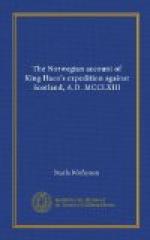[Footnote 46: i.e. gold.]
[Footnote 47: i.e. ship.]
[Footnote 48: Kirkio-vog (orig.) i.e. Church-bay. Kirkwall.]
[Footnote 49: Breida-fiardar (orig.), i.e. Broad bay. The firth of Forth.]
[Footnote 50: St Olave’s day, July 29.]
[Footnote 51: Mula in Irish and Icelandic signifies a cape or beak.]
[Footnote 52: Kata-nes (orig.), i.e. the promontory of Cadtav or Cathness. Cathness was particularly exposed to the inroads of the Norwegians. On this account great numbers of the inhabitants retired into Murray and the adjacent counties, where they were afterwards known by the name of Clan-Chattan.]
[Footnote 53: i.e., the promontory, or Cathness.]
[Footnote 54: Baug-gerdar (orig.), i.e. imposer of rings. Baug signifies anything circular, therefore, in compounded words, it is not easy to discern when it denotes rings or shields, &c. See note on ringa, p. 19.]
[Footnote 55: This eclipse happened on the 5th of August 1263.]
[Footnote 56: St Laurence’s wake or vigil, 9th of Aug.]
[Footnote 57: Cathness by the ancient Britons was called Pentir, i.e. the headland, whence the neighbouring firth had its name.]
[Footnote 58: i.e. John the Queen, perhaps the ancestor of the McQueens.]
[Footnote 59: Asleifarvik (orig.). Fl. MS., Hals-eyiar-vic.]
[Footnote 60: i.e. The old woman’s rock. Cailleach in Irish, and kerling in Icelandic signify an old woman.]
[Footnote 61: i.e. The promontory. This island was so called because, from its propinquity to the opposite shore, it appeared like a cape. The old Venetian edition of Pliny has “Mella xxv mill. pass. amplior proditur;” in the other copies it is “Reliquarum nulla” &c. Hence the true reading appears to be Reliquarum Mulla &c.]
[Footnote 62: Ken-tir, i.e. the promontory, a Peninsula in Scotland, Kintire.]
[Footnote 63: i.e. God’s-Island. I take this to be Giga, or, as Fordon calls it, Gia, compounded of the Gaelic Dhia, God, and the Islandic ey, an island.]
[Footnote 64: Who this Margad was does not appear from history, I believe.]
[Footnote 65: Angus, Lord of Kintire and Ila, was grandson & heir of Reginald king of the isles. His posterity succeeded to the county of Ross, & John, the second Earl, A.D. 1449, gave to his Brother Hugh the Barony of Slate &c. Lord McDonald Baron of Slate, is the direct male representative of Reginald.]
[Footnote 66: i.e., rings or bracelets.]
[Footnote 67: i.e., ships.]
[Footnote 68: i.e. the sea.]
[Footnote 69: A celebrated adventurer or sea king.]




